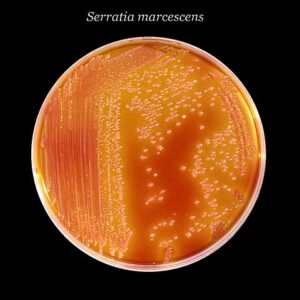
The pink or even red staining that can occur in showers and bathtubs is often mistaken for mold or even marine algae (Red Algae). However, the discoloration is most likely to be a particular kind of bacterial growth known as Serratia marcescens.
S. Marcescens is an airborne pathogen that would likely be carried into the house by way of humans, pets, or even on a breeze through an open door or window in warmer months or any time if you live in a warmer climate.
It will often be found growing on shower walls, mostly on the grout, shower curtains, and other course materials that will become wet and stay wet for extended periods. It will also be found growing on an eroded water ring within older toilets. The bacteria like humid environments and tends to feed on the mineral deposits found in soap scum and the fats found in both soap and shampoo residue left behind after a shower or bathtub has been used.
The “Pink Mold” can be harmful to your health
Serratia marcescens is a bacteria that can cause what are known as “opportunistic infections” ranging from pink-eye to the urinary tract and respiratory tract infections and, according to Wikipedia, “is also a rare cause of endocarditis and osteomyelitis (particularly in people who use intravenous drugs recreationally), pneumonia, and meningitis.
Most S. marcescens strains are resistant to several antibiotics (Wikipedia). In 1950, it was used as a substitute for another more lethal bacteria in a military bio-weapons development test called “Operation Sea Spray” where the Serratia Marcescens bacterial was placed into balloons and released over San Francisco. As a result, several people came down with a rare and serious urinary tract infection and many came down with pneumonia. Since 1950, S. marcescens has steadily increased as a cause of human infection, with many strains resistant to multiple antibiotics.
Best ways to remove the threat of Serratia marcescens
Eradication of the bacteria from your home will require using a cleaning agent that includes chlorine bleach. However, if the bacteria has been present for some time, it will be likely that the grout will have to be replaced as S. Marcescens can penetrate deeply into the grout. Other materials, such as plastic or Formica and the like, will be susceptible to some staining but will not necessarily allow for deep penetration.
Prevention will call for creating an inhospitable environment for the bacteria: it may be practical to install a bathroom fan with a heating element to eject and dry the air and tile grout. As well, if possible, wipe down the tiles, grout, and any other amenities that could hold water and/or lingering soaps, shampoos, and hair conditioner. Diligence will be key in this issue.
Removing Pink Mold (S. Marcescens):
S. marcescens comes with a very stubborn biofilm to protect itself. The only way to remove it is with hard scrubbing with a thick (not too watery but still thinner than the consistency of peanut butter) solution of baking soda and dish soap. The dish soap contains desiccants to help break down the film chemically and the baking soda is for the more abrasive part of the approach.
It’s important to remind you here that S. Marcesens is harmful to your health, so you will want to suit up with safety goggles, a respirator mask, and gloves for this part of the operation.
Recommended Safety Items (Can be found at any hardware store):
Amazon links placed here for your convenience
Scrub hard with a soft bristle brush or sponge. be sure to get all the hard and soft surfaces in your shower. Everywhere from the soap dish to countertops seats glass doors and the like. When the scrubbing is through, rinse away the residue with warm water.
Disinfecting your bathroom surfaces:
The surfaces you have just finished cleaning still need to be disinfected as there are likely still some particles leftover that will be coming back quickly if left to fester. To manage the disinfection, you will need a cleaning solution containing chlorine as it will not only kill any remaining spores but will bleach out any of the lingering stains, should you still have them.
I would recommend a solution of 3 ounces of chlorine bleach to 9 ounces or so of water into a spray bottle. Shake the contents and spray the surfaces you had cleaned with the sponge and baking soda and dish soap. Let the bleach solution stand for 5 to 10 minutes. Then, using a fresh sponge, scrub down the surfaces to which you have applied the bleach solution. When done, rinse down the surfaces cleaned and then wipe down with a clean dry towel.
If you have a shower curtain, you will want to put that into the washing machine under a gentle setting and detergent. If your manufacturer allows for it, you could use some bleach to be certain. Otherwise, standard washing should do the trick.
Prevention of Pink Mold:
Unfortunately, the only way out of this one is through diligence. Yes, even after all you will have just gone through, you will need to create an unfriendly environment for the Pink Mold in order to discourage its return. To aid in this, it is highly recommended install and be certain to use a bathroom fan (preferably one with heat). Start the fan when you turn on the water and be sure to let it run after your shower for at least 10 minutes to dry out the abiant air. Remember as well, S. Marsecens is most likely to be found on routinely wet or damp areas. In order to keep it at bay, you will need to dry your shower after each use, with a towel or, even better, a squeagey.
You will want to make the cleaning of soap scum and any residue left behind from shampoo, soaps, etc. to be done on a bi-weekly (ever two weeks) basis. My wife and I use a white vinegar, water, baking soda and pure lemon juice solution as it works well and fast. Apply with a sponge, work it in and let it sit for 20 minutes for best results. Then, rinse and dry as described above. Run the bathroom fan, if you have one, to aid in the drying process.
The Serratia Marcesens bacteria is airborne, all the time. If you cannot keep up the routine above, you should know that it’s not the end of the world, but you can depend on the Pink Mold’s return. If, afterall this, you cannot seem to get rid of the pink staining, it’s likely time to replace the grout in your shower and maintain from that point.
If replacing the grout is all that’s left you, it’s not as hard to do as you may think. And, you may actually enjoy learning a new and quite valuable household skill.
In any of the above, remember to be safe by using your protective eye wear, resperator and gloves. It is a real bacteria afterall. Respect it as such and, you will be successful.
Best of Luck and Good Health,
Berk
